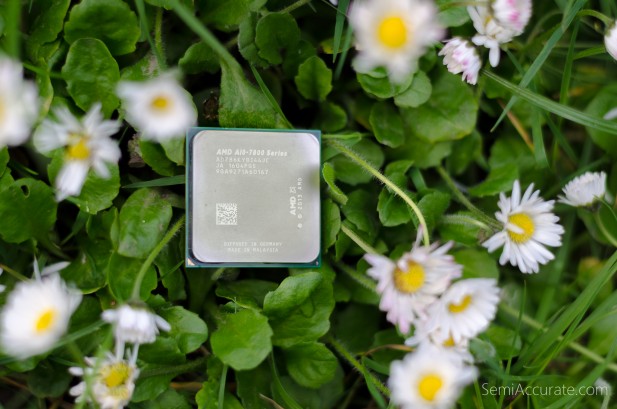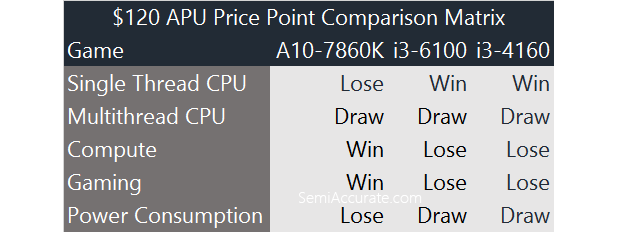In this review we’ll be comparing AMD’s new 65W A10-7860K APU to one of the chips it replaces in AMD’s product stack: the venerable 95W A10-7850K. The 7860K and the 7850K are very similar products. They both have 8 GCN Compute Units and four Steamroller CPU cores with support for memory speeds of up to DDR3-2133. They differ in three places: power consumption, clock speeds, and cTDP limits.
The 7860K cuts the 7850K’s 95 Watt TDP by a third to 65 Watts. Interestingly clock speeds are down by only by 3 percent on base clock and turbo boost speeds are the same. The GPU’s clock rate is actually up by 5 percent on the 7860K compared to the old 7850K. This leads us to believe that some combination of process improvements, binning, and more aggressive power management are enabling the 7860K to draw so much less power compared to the 2-year-old 7850K. As for cTDP limits the 7850K could go down to 65 Watts while the new 7860K can go even further down to 45 Watts.

Power Consumption
To verify AMD’s claims of lower power consumption we broke out our trusty Kill-Watt-EZ and then measured complete system power consumption from the wall.
The results of AMD’s efforts with the A10-7860K are pretty clear in these tests. The 7860K draws 7 Watts less at idle and 22 Watts less under load. The 7860K’s 45 Watt cTDP mode also delivers by cutting power consumption down to almost half of what the older 7850K drew at load.
With the A10-7860K’s power consumption and cTDP advantages over the 7850K confirmed it’s now time to find out if it can keep up in terms of performance. It’s important to remember that AMD is positioning the A10-7860K as a direct replacement in its product stack for the 7850K. Thus what we’re looking for here is a draw in terms of performance.
Too Long; Didn’t Read
If you’re a subscriber you can now find our testing methodology, exact hardware configurations, a detailed justification of these benchmarks, and our raw testing data at the very end of the article. We’ve opted to place that information behind our paywall with the acknowledgement that few people actually read those parts of our reviews and with the goal of making these articles easier to read for people who aren’t interested in those aspects of our content.
Transparency Statement
For the sake of transparency, we want you to know that AMD provided both of the APUs and the DDR3 memory we’ll be testing in this review. All the other components were purchased at retail and without the knowledge or consent of those companies. We took no outside input for this article.
Test Results
Again the A10-7860K’s goal here is a draw, or at least as close as possible to a draw that it can get.
There you have it: it’s a draw. The A10-7860K and the 7850K it replaces perform almost identically. The only notable difference is in multicore performance where the A10-7860K is behind by 6 percent because it bombed in our H.265 encoding benchmark. Ignoring that single result the gap closes back up to only 2 percent.
In the end these desktop APUs are essentially identical in CPU, GPU, and compute performance. Of course that’s what we were hoping to see.
Pricing
With performance and power consumption pinned down the only issue left to consider is pricing. Right now you can find the retail boxed version of the A10-7860K on Amazon for about $120 complete with AMD’s Cooler Master-branded 95 Watt near-silent cooling solution. This slots it in right on top of the old 7850K’s price point at $115. On the other hand this puts it in direct competition with Intel’s Core i3 chips. The Skylake-based Core i3-6100 comes in at $125 and a Haswell SKU the Core i3-4160 is at $120.
Conclusions
The A10-7860K is easy to recommend over the old A10-7850K. Recommending it over one of Intel’s Core i3 chips is more complex. Our simple comparison matrix shows that using the metrics that we test for in these reviews the AMD versus Intel decision is a bit of a tossup.
In terms of CPU performance we can expect Intel’s chips to win by a very significant margin in single threaded applications. In our initial 7850K review we found that chip only offers about 60 percent of the single threaded performance of Intel’s old Haswells chips. We expect this trend would continue in any 7860K versus i3 match up. These i3’s though are only dual core chips which means that despite their performance in single threaded apps we would expect to see something of a draw in multithreaded scenarios. As far as compute and gaming performance are concerned the 7860K GPU is better than anything Intel’s i3’s can muster. Finally we have power consumption which despite the 7860K’s improvements over the 7850K we believe Intel would still hold a lead given the lower 54 and 51 Watt TDPs of Intel i3’s.
There are two other items that I think are worth considering in this match up. The strength of AMD’s new near-silent stock cooler and performance alongside a discrete GPU. The noise profile of AMD’s new cooler is a big improvement over both what they offered before and Intel’s stock cooler. It’s actually good enough to beat out most entry-level aftermarket coolers. If you’re planning on sticking with the stock cooler for an Office or Low-cost PC build then AMD’s cooler could be a tie breaker. On the other end Intel’s i3s will walk away from this APU when paired with a discrete GPU in popular mainstream games most of which are DirectX 9 or 11 apps that make only limited use of multiple cores and scale well with strong single threaded performance.
It’s great that the ~$120 price point is so competitive but in the end choosing the right chip in this segment is going to depend on how well suited the characteristics of these chips are to your use case. If you’re building a low-cost PC for web browsing then the A10-7860K is the right choice, but if you’re planning on adding a discrete GPU for gaming then an Intel i3 would be a better option. Whatever you decide just make sure you pair it with an SSD to ensure the best user experience possible.
Note: The following is for professional and student level subscribers.
Disclosures: Charlie Demerjian, Thomas Ryan and Stone Arch Networking Services, Inc. have no consulting relationships, investment relationships, or hold any investment positions with any of the companies mentioned in this report.
Thomas Ryan
Latest posts by Thomas Ryan (see all)
- Intel’s Core i7-8700K: A Review - Oct 5, 2017
- Raijintek’s Thetis Window: A Case Review - Sep 28, 2017
- Intel’s Core i9-7980XE: A Review - Sep 25, 2017
- AMD’s Ryzen Pro and Ryzen Threadripper 1900X Come to Market - Aug 31, 2017
- Intel’s Core i9-7900X: A Review - Aug 24, 2017



